chapter 1 general principles 连淑能《英译汉教程》
《英译汉教程》(连淑能主编,高等教育出版社)-第10~12章【圣才出品】

第10章Division(拆译法)10.1 复习笔记In division, we have to determine where to divide, how to divide, what the subject or the predicate of the new clause or sentence should be, and how to rearrange various parts of the original sentence. These may involve such techniques as Conversion, Addition and Inversion.拆分时要注意以下问题:在哪里拆分,怎样拆分,新的从句或句子的主语、谓语分别是什么,以及如何重新组织这些部分。
这里涉及到的技巧有转换法、增补法和倒置法。
一、Picking Out of Words(拆译单词)It is advisable to pick out those words which are hard to reproduce in the original structure and expand them into Chinese word groups, clauses or sentences. There are usually three steps to deal with such words:翻译过程中,如果一个单词的意义很难用汉语在原有句法框架下表达出来,就可以把该单词抽取出来,并将其扩展为汉语词组、从句或句子。
具体操作步骤如下:1. Determine which word(s) to pick out;确定需要抽取出来的单词;2. Apply Conversion or Addition, if necessary, to make the translated version smooth and well-connected;必要时运用转换法或增补法,使译文流畅、通顺;3. Rearrange the word order according to the Chinese mode of expression.根据汉语表达习惯,重新组织语序。
《高级笔译》课程教学大纲
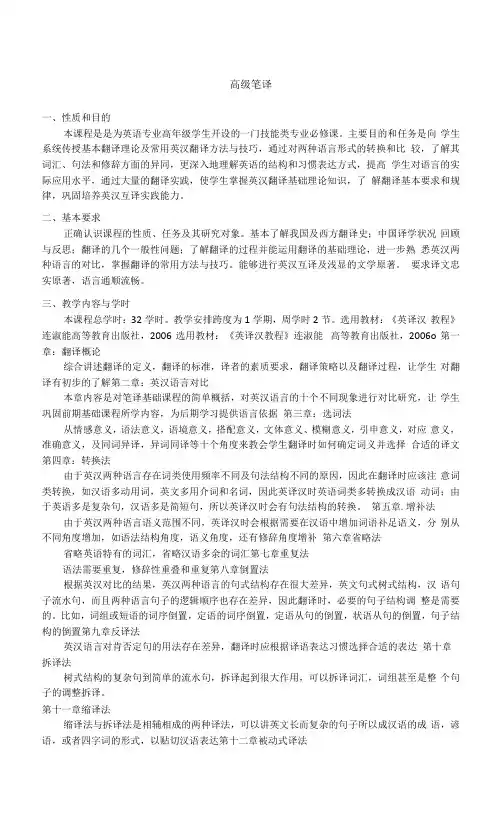
高级笔译一、性质和目的本课程是是为英语专业高年级学生开设的一门技能类专业必修课。
主要目的和任务是向学生系统传授基本翻译理论及常用英汉翻译方法与技巧,通过对两种语言形式的转换和比较,了解其词汇、句法和修辞方面的异同,更深入地理解英语的结构和习惯表达方式,提高学生对语言的实际应用水平,通过大量的翻译实践,使学生掌握英汉翻译基础理论知识,了解翻译基本要求和规律,巩固培养英汉互译实践能力。
二、基本要求正确认识课程的性质、任务及其研究对象。
基本了解我国及西方翻译史;中国译学状况回顾与反思;翻译的几个一般性问题;了解翻译的过程并能运用翻译的基础理论,进一步熟悉英汉两种语言的对比,掌握翻译的常用方法与技巧。
能够进行英汉互译及浅显的文学原著。
要求译文忠实原著,语言通顺流畅。
三、教学内容与学时本课程总学时:32学时。
教学安排跨度为1学期,周学时2节。
选用教材:《英译汉教程》连淑能高等教育出版社,2006选用教材:《英译汉教程》连淑能高等教育出版社,2006o第一章:翻译概论综合讲述翻译的定义,翻译的标准,译者的素质要求,翻译策略以及翻译过程,让学生对翻译有初步的了解第二章:英汉语言对比本章内容是对笔译基础课程的简单概括,对英汉语言的十个不同现象进行对比研究,让学生巩固前期基础课程所学内容,为后期学习提供语言依据第三章:选词法从情感意义,语法意义,语境意义,搭配意义,文体意义、模糊意义,引申意义,对应意义,准确意义,及同词异译,异词同译等十个角度来教会学生翻译时如何确定词义并选择合适的译文第四章:转换法由于英汉两种语言存在词类使用频率不同及句法结构不同的原因,因此在翻译时应该注意词类转换,如汉语多动用词,英文多用介词和名词,因此英译汉时英语词类多转换成汉语动词;由于英语多是复杂句,汉语多是简短句,所以英译汉时会有句法结构的转换。
第五章.增补法由于英汉两种语言语义范围不同,英译汉时会根据需要在汉语中增加词语补足语义,分别从不同角度增加,如语法结构角度,语义角度,还有修辞角度增补第六章省略法省略英语特有的词汇,省略汉语多余的词汇第七章重复法语法需要重复,修辞性重叠和重复第八章倒置法根据英汉对比的结果,英汉两种语言的句式结构存在很大差异,英文句式树式结构,汉语句子流水句,而且两种语言句子的逻辑顺序也存在差异,因此翻译时,必要的句子结构调整是需要的。
英译汉教程1_基础词汇
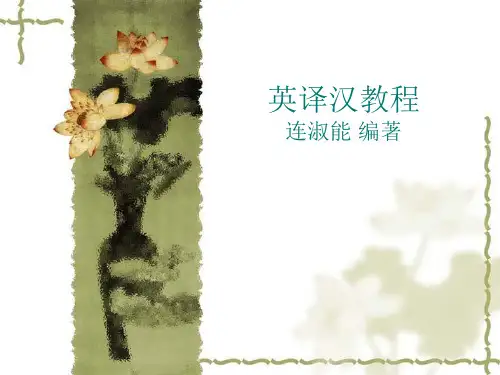
a consensus: to favor literal translation whenever possible and free translation whenever literal translation is not a good choice.
(能够直译尽量直译,不能直译则意译)
英译汉教程
连淑能 编著
Chapter 1 General Principles
Self-introduction / Getting to know each other An introduction to the course 1.course description: a practical course; a proficiency course; the training of translating skills
Discussion:
What are the merits and demerits of literal translation and free translation respectively? What are the extremes of literal translation and free translation? please offer appropriate examples to illustrate them
General principles about translation
How do you perceive translation? The definition of translation:
translation can be roughly defined as a reproduction or recreation in one language of what is written or said in another language.
《英译汉教程》____练习参考答案
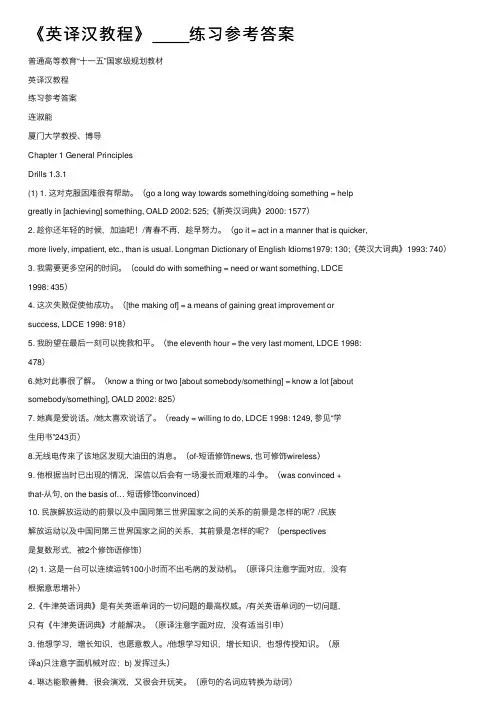
《英译汉教程》____练习参考答案普通⾼等教育“⼗⼀五”国家级规划教材英译汉教程练习参考答案连淑能厦门⼤学教授、博导Chapter 1 General PrinciplesDrills 1.3.1(1) 1. 这对克服困难很有帮助。
(go a long way towards something/doing something = helpgreatly in [achieving] something, OALD 2002: 525;《新英汉词典》2000: 1577)2. 趁你还年轻的时候,加油吧!/青春不再,趁早努⼒。
(go it = act in a manner that is quicker,more lively, impatient, etc., than is usual. Longman Dictionary of English Idioms1979: 130;《英汉⼤词典》1993: 740)3. 我需要更多空闲的时间。
(could do with something = need or want something, LDCE1998: 435)4. 这次失败促使他成功。
([the making of] = a means of gaining great improvement orsuccess, LDCE 1998: 918)5. 我盼望在最后⼀刻可以挽救和平。
(the eleventh hour = the very last moment, LDCE 1998:478)6.她对此事很了解。
(know a thing or two [about somebody/something] = know a lot [aboutsomebody/something], OALD 2002: 825)7. 她真是爱说话。
/她太喜欢说话了。
(ready = willing to do, LDCE 1998: 1249, 参见“学⽣⽤书”243页)8.⽆线电传来了该地区发现⼤油⽥的消息。
连淑能《英译汉教程》TranslationofLongSentences(长句译法)【圣才出品】
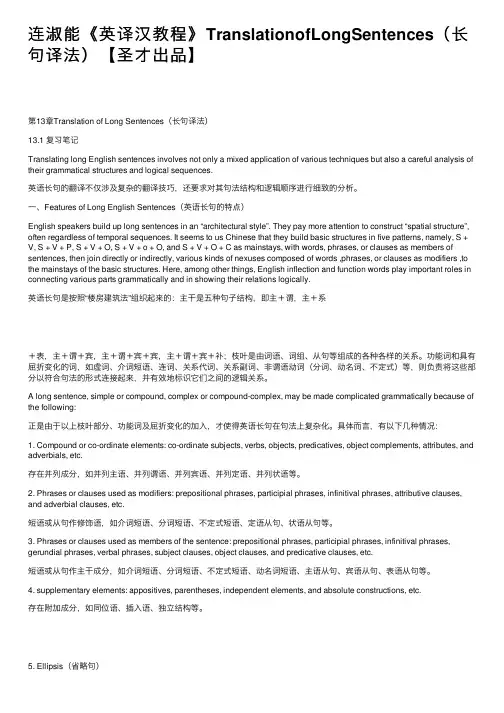
连淑能《英译汉教程》TranslationofLongSentences(长句译法)【圣才出品】第13章Translation of Long Sentences(长句译法)13.1 复习笔记Translating long English sentences involves not only a mixed application of various techniques but also a careful analysis of their grammatical structures and logical sequences.英语长句的翻译不仅涉及复杂的翻译技巧,还要求对其句法结构和逻辑顺序进⾏细致的分析。
⼀、Features of Long English Sentences(英语长句的特点)English speakers build up long sentences in an “architectural style”. They pay more attention to construct “spatial structure”, often regardless of temporal sequences. It seems to us Chinese that they build basic structures in five patterns, namely, S + V, S + V + P, S + V + O, S + V + o + O, and S + V + O + C as mainstays, with words, phrases, or clauses as members of sentences, then join directly or indirectly, various kinds of nexuses composed of words ,phrases, or clauses as modifiers ,to the mainstays of the basic structures. Here, among other things, English inflection and function words play important roles in connecting various parts grammatically and in showing their relations logically.英语长句是按照“楼房建筑法”组织起来的:主⼲是五种句⼦结构,即主+谓,主+系+表,主+谓+宾,主+谓+宾+宾,主+谓+宾+补;枝叶是由词语、词组、从句等组成的各种各样的关系。
连淑能《英译汉教程》配套题库(含考研真题)-Chapter 3~Chapter 4【圣才出品】
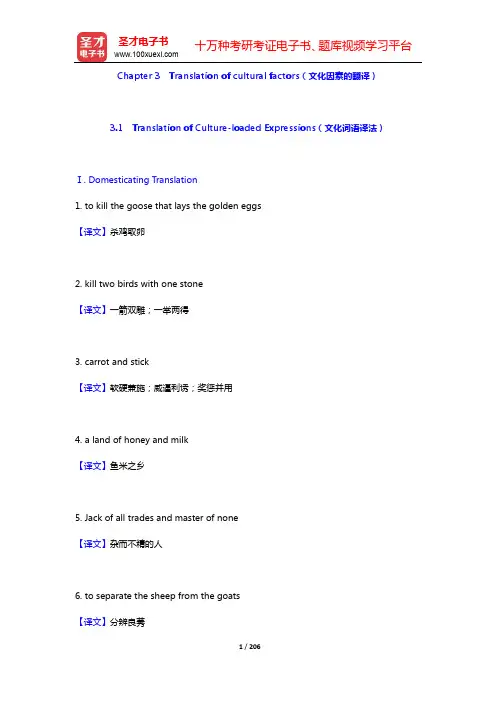
Chapter 3 Translation of cultural factors(文化因素的翻译)3.1 Translation of Culture-loaded Expressions(文化词语译法)Ⅰ. Domesticating Translation1. to kill the goose that lays the golden eggs【译文】杀鸡取卵2. kill two birds with one stone【译文】一箭双雕;一举两得3. carrot and stick【译文】软硬兼施;威逼利诱;奖惩并用4. a land of honey and milk【译文】鱼米之乡5. Jack of all trades and master of none【译文】杂而不精的人6. to separate the sheep from the goats【译文】分辨良莠7. to take French leave【译文】不告而别8. to carry coals to Newcastle【译文】多此一举【解析】纽卡斯尔是英国煤炭重镇,故往纽卡斯尔运煤是多此一举。
9. to paint the lily【译文】画蛇添足10. to face the music【译文】临危不惧11. to mind one’s P’s and Q’s【译文】谨言慎行12. to put the cart before the horse【译文】本末倒置13. to laugh off one’s head【译文】笑掉大牙14. as timid as a rabbit【译文】胆小如鼠15. as mute as a fish【译文】噤若寒蝉16. neither fish nor flesh【译文】不伦不类17. six of one and half a dozen of the other【译文】半斤八两18. to spend money like water【译文】挥金如土19. to look for a needle in haystack【译文】大海捞针20. Better be the head of a dog than the tail of a lion. 【译文】宁为鸡头,不为凤尾。
连淑能《英译汉教程》Translation of Proper Nouns and Technical Terms(专有名词和专门术语译法)
第15章Translation of Proper Nouns and Technical Terms(专有名词和专门术语译法)15.1 复习笔记English proper nouns include names of persons, places, organizations ,newspapers, periodicals, radios, news agencies, books, films, etc. English technical terms include, broadly speaking, special words or expressions for things and ideas used in any branch of science and technology.英语专有名词包括人名、地名、组织名、报纸名、期刊名、广播台名、通讯社名、书名、电影名等等。
英语专有术语主要包括在技术科学、社会科学、自然科学等领域广泛运用的特殊词汇或特殊表达。
Many troubles arise in translating proper names and technical terms. Great confusion may come from.在翻译专有名词和专有术语的时候会遇到一些棘手的问题,这些问题主要来源于:1. Transliteration of proper names from English spelling or pronunciation;对英语专有名词的发音直接进行音译;2. Variation in the spoken sound of Chinese characters used in translated names;汉语中部分汉字的发音有地域区别;3. Large number of homonyms, homophones and homographs in Chinese;汉语中有大量同音字、多音字和同形字;4. Mixed use of old and new translated names.新译法和旧译法的混合使用。
英译汉教程连淑能配套练习题库
英译汉教程连淑能配套练习题库|才聪学习网连淑能《英译汉教程》配套题库(含考研真题)目录Chapter 1 Lexical Translation(词法翻译)1.1 Diction(选词法)1.2 Conversion(转换法)1.3 Addition(增补法)1.4 Omission(省略法)1.5 Repetition(重复法)Chapter 2 Syntactical Translation(句法翻译)2.1 Inversion(倒置法)2.2 Negation(反译法)2.3 Division(拆译法)2.4 Condensation(缩译法)2.5 Translation of the Passive(被动句的译法)2.6 Translation of Long Sentences(长句译法)Chapter 3 Translation of cultural factors(文化因素的翻译)3.1 Translation of Culture-loaded Expressions(文化词语译法)3.2 Translation of Proper Nouns and Technical Terms(专有名词和专门术语译法)Chapter 4 Style and Translation(文体与翻译)4.1 Political Writing(政治文体)4.2 Journalistic Writings(新闻报刊文体)4.3 Popular Science Writing(科普文体)4.4 Practical Writing(应用文体)4.5 Literary Style(文学文体)•试看部分内容Chapter 1Lexi cal Transla tion(词法翻译)1.1 Diction(选词法)Ⅰ. Choice of Affective Meanings1. In ou r Se con d Addre ss on the war, fi ve days af te rt h e a d v e n t o f th o s e m e n,w e to l d y o u w h a t th e y w e r e.【译文】在这伙人上台五天以后,我们在关于前次战争的第二篇宣言中已经向你们说明他们究竟是些什么货色了。
《英译汉教程》(连淑能主编,高等教育出版社)-第4~6章【圣才出品】
第4章Conversion(转换法)4.1 复习笔记一、Conversion of Word Classes(转换词类)In translation, a word in one language belonging to a certain word class is not necessarily translated into one of the same class in another language.在翻译过程中,一种语言的某一词类不一定要相应地译为另一语言中相应的词类,有时候进行适当转化是十分必要的。
1. Conversion from English Nouns and Adjectives into Chinese Verbs and Adverbs(英语名词、形容词转换为汉语动词、副词)Nouns or nominal dorms, especially action nouns and other abstract nouns, find their wider use in English while verbs or multi-verbal forms are much preferred in Chinese. In translation, therefore, the conversion of English nouns into Chinese verbs, and subsequently English adjectives into Chinese adverbs, becomes one of the techniques frequently employed for smooth representation in idiomatic Chinese.英语中多用名词或名词短语,尤其是动作名词和其他抽象名词,而汉语中多用动词,甚至多个动词连用的情况。
chapter 1 general principles 连淑能《英译汉教程》(课堂PPT)
.
15
❖翻译是把第一种语言(源语)语篇 所表达的东西用第二种语言(目的 语)重新表达出来,尽量保持语义 与文体方面的等值。
.
16
❖ Translation may be defined as the replacement of textual material in one language (the source language) by equivalent textual material in another language (the target language).
Chapter 1 General Principles
❖ The Definitions of Translation
❖ The Categories of Trቤተ መጻሕፍቲ ባይዱnslation
❖ The Assessment of Translation
❖ The Competence of A Translator
❖ Translation Strategies
❖ Translation Processes
.
1
❖ 译即易,谓换易言语使相解也。 ——唐·贾公彦:《义疏》
❖ 把已说出或写出的话的意思用另一种语 言表达出来的活动。
——《中国大百科全书·语言文字卷》
.
2
❖ 翻译的实质是语际的意义转换。 ——刘宓庆
—Nida & Taber. The Theory and Practice of Translation
.
10
❖ 翻译就是在译入语中再现与原语的信息 最切近的自然对等物,首先是就意义而 言,其次是就文体而言。 ——奈达
.
- 1、下载文档前请自行甄别文档内容的完整性,平台不提供额外的编辑、内容补充、找答案等附加服务。
- 2、"仅部分预览"的文档,不可在线预览部分如存在完整性等问题,可反馈申请退款(可完整预览的文档不适用该条件!)。
- 3、如文档侵犯您的权益,请联系客服反馈,我们会尽快为您处理(人工客服工作时间:9:00-18:30)。
翻译就是用一种语言把另一种语言
在内容与形式不可分割的统一中所 业已表达出来的东西准确而完全地 表达出来。 ——安德烈· 费道罗夫
翻译是把一种语言的言语产物在保持
内容方面(也就是意义)不变的情况 下改变为另外一种语言的言语产物的 过程。 ——巴尔胡达罗夫
1. languages involved translation from native language into a foreign language and vice versa.
Chapter 1 General Principles
The
Definitions of Translation The ment of Translation The Competence of A Translator Translation Strategies Translation Processes
翻译是许多语言活动中的一种,它是用一
种语言形式把另一种语言形式里的内容 重新表现出来的语言实践活动。翻译是 一门艺术,是语言艺术的再创造。 ——冯庆华
翻译是把一种语言(即源语)的信息用
另一种语言(即译语)表达出来,使译 文读者能得到原作者所表达的思想,得 到与原文读者大致相同的感受。 ——范仲英:《实用翻译教程》
“翻译,的确可以帮助我们造出许多新的
字眼,新的句法,丰富的词汇和细腻的 精密的正确的表现。因此,我们既然进 行着创造中国现代的新的言语的斗争, 我们对于翻译,就不能够不要求:绝对 的正确和绝对的中国白话文。” ——瞿秋白《关于翻译的通信》
2. working style oral translation/ interpreting 口译
(consecutive interpreting CI交替传译; simultaneous interpreting SI同声传译 ) ;
written translation 笔译.
3. different ways of handling absolute translation (全译) ; selective translation (摘译); translation with reconstruction (编译).
翻译是把第一种语言(源语)语篇
所表达的东西用第二种语言(目的 语)重新表达出来,尽量保持语义 与文体方面的等值。
Translation
may be defined as the replacement of textual material in one language (the source language) by equivalent textual material in another language (the target language). — John Catford 翻译是把一种语言(源语)的文字材料 转换成另一种语言(译语)的对等的文 字材料。
鲁迅&瞿秋白
vs. 赵景深 dichotomy between “faithfulness” and “smoothness”
The
focus of the debate was which principle should take priority in translating. “faithfulness” : fundamental principle; literal translation “smoothness” had priority over “faithfulness”, for the reader of the target language preferred a translation easy to read.
“翻译必须有异国情调,就是所谓洋气。其实 世界上也不会有完全归化的译文,倘有,就是 貌合神离,从严辨别起来,它算不得翻译。凡 是翻译,必须兼顾着两面,一当然力求其易解, 一则保存着原作的丰姿,但这保存,却又常常 和易懂相矛盾:看不惯了。不过它原是洋鬼子, 当然谁也看不惯,为比较的顺眼起见,只能改 换他的衣裳,却不该削低他的鼻子,剜掉他的 眼睛。我是不主张削鼻剜眼的,所以有的地方, 仍然宁可译得不顺口。” ——《鲁迅全集》
主张“质”的翻译家则强调翻译的
不增不减,强调翻译的忠实性。
严复-“信、达、雅”
faithfulness,
expressiveness and elegance
In
translating there are three things that are difficult to achieve: faithfulness, expressiveness and elegance. To be faithful to the original is already very difficult, and yet a translation faithful but not expressiveness comes to no translation at all. Therefore, expressiveness has to be given weight.
主张“文”的翻译家强调翻译的修
辞和通顺; 强调译文的可读性;
the
faithfulness and intelligibility of translation beautiful words are not faithful, and faithful words are not beautiful
翻译是将一种语言文字所蕴含的意思用
另一种语言文字表达出来的文化活 动。 ——王克非
翻译是一种语言文字的实践,是利用一种
语言文字将另一种语言文字所表达的思想 确切而完善地重新表达出来的实践。 ——汪涛、黄新渠
黄 新 渠 译
翻译是以译者为主体,以语言为转换媒介
的创造性思维活动。所谓翻译,就是把见 诸于一种语言的文本用另一种语言准确 而完整地再造出来,使译作获得与原作相 当的文献价值或文学价值。 ——王宏印
to turn from one language into another
—The Oxford English Dictionary
to turn into one’s own or another language —Webster’s third New International Dictionary of the English Language
A
good translation is one which the merit of the original work is so completely transfused into another language as to be as distinctly apprehended and as strongly felt by a native of the country to which that language belongs as it is by those who speak the language of the original work. — Alexander Fraser Tytler
好的翻译应该是把原作的长处完全地移
注到另一种语言,以使译人语所属国家 的本地人能明白地领悟、强烈地感受, 如同使用原作语言的人所领悟、所感受 的一样。 ——泰特勒
Translation
is the expression in another language (or target language) of what has been expressed in another, source language, preserving semantic and stylistic equivalences. — Roger Bell
Function
of the three-character principle by Yan Fu a milestone in China’s translation history extracts the essence from Buddhist translation studies of the Han and Tang Dynasties; opens a new era for modern translation studies.
—Nida & Taber. The Theory and Practice of Translation
翻译就是在译入语中再现与原语的信息
最切近的自然对等物,首先是就意义而 言,其次是就文体而言。 ——奈达
Translation
is a craft consisting in the attempt to replace a written message and /or statement in one language by the same message and/or statement in another language. —Perter Newmark. Approaches to Translation
译即易,谓换易言语使相解也。
——唐· 贾公彦:《义疏》
把已说出或写出的话的意思用另一种语
言表达出来的活动。 ——《中国大百科全书· 语言文字卷》
翻译的实质是语际的意义转换。
——刘宓庆
翻译是运用一种语言把另一种语言所表
达的思维内容准确而完整地重新表达出 来的语言活动。 ——张培基等:《英汉翻译教程》
Translating is the art of recomposing a work in another language without losing its original flavor.
